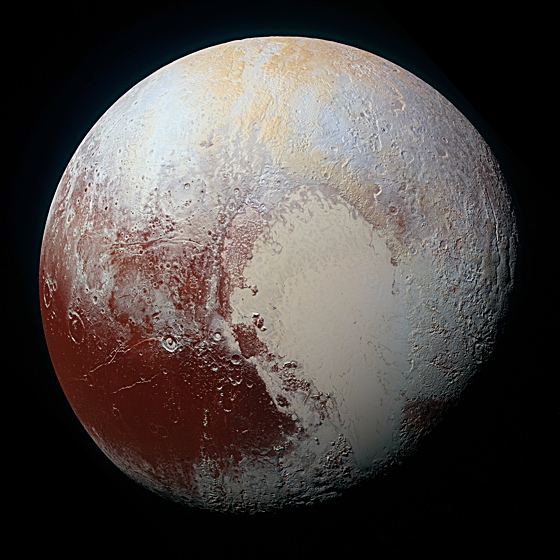
We have arrived at the midpoint of In the cells of the eggplant. In its first part, we saw how every attempt to make rationalism work failed, in each case because it denied ontological nebulosity. The second part explains how meta-rationality works with ontological nebulosity to resolve the problems rationalism encountered.
Formal rationality usually works within a fixed ontology, unquestioned and often implicit. That works well so long as the ontology is good enough for the job at hand. When it isn’t, total breakdown can result, because rationality has no way of repairing the breach.
Meta-rationality stands outside any particular ontology. It treats ontologies as malleable, and manipulates them explicitly. It evaluates, selects, combines, modifies, discovers, and creates alternative ones.
Ontological remodeling—the reconfiguration of individuation criteria, categories, properties, and relationships—is a relatively advanced meta-rational activity. Ideally, we would build up extensive conceptual prerequisites before discussing it. The topic might be best left to the end of The eggplant—or, in fact, to some other text.1
Except that we need this idea to explain what sort of thing meta-rationality is. Namely, meta-rationality is itself an ontological remodeling of rationality.
This coincidence is potentially confusing. We need to recognize ontological remodeling at two levels:
- At the meta level, moving from rationalism to meta-rationality requires remodeling the fundamental ontological categories of rationality, such as truth, belief, deduction, induction, and so on.
- At the object level, ontological remodeling is a major aspect of the subject matter of meta-rationality.
So the shift from the rationalist to meta-rational view is an instance of the thing meta-rationalism describes. This is unfortunate, because it implies that meta-rationality is required in order to understand meta-rationality. Formal rationality doesn’t include an account of ontological remodeling, which is the skill needed to see the possibility of an alternative view. So meta-rationalism is a prerequisite for itself, which is part of what makes the shift difficult.
As always when something is a prerequisite for itself, you have to proceed in a spiral. An approximate understanding of a small part of the subject makes it possible to grasp more of it, and thereby to revise your understanding of the initial beachhead. You need repeated passes over the topic, in increasing breadth and depth, to master it.
So this “middle bit” of The Eggplant provides a rough, informal, partial account of ontological remodeling—enough to help the second major part make sense.
To make it concrete, I use examples taken from the history of science. I find them interesting for their own sake, and I hope you too find them enjoyable as well as enlightening.
The extinction and survival of categories
Often remodeling begins by recognizing that a category isn’t a well-defined grouping for which there can be a meaningful, unified story.
During ontological remodeling, a category may:
- Disappear completely
- Convert from formal to informal status
- Get a new formal meaning
A category disappears when it turns out there’s nothing in it—the entities it grouped don’t exist—or when it groups entities that have nothing meaningfully in common. In scientific history, categories like phlogiston, the luminiferous aether, and the Philosopher’s Stone turned out to have nothing in them, and got dropped. The taxon “Bestiae,” the Great Chain of Being, and the Hippocratic humors turned out to group genuine entities in useless ways, and so were also dropped.
The second possible outcome is that a category turns out to be too stubbornly nebulous for any formal account of it to work. Then it may hang on informally. It is no longer “officially” part of the new ontology, but people still talk about it, because it’s heuristically useful. Some or all entities in the category may get new, formal, detailed and precise accounts, which are actually much more accurate than before reformulation, but the general case remains vague.
For instance, fire was an ontologically basic, formal category for thousands of years. After the Chemical Revolution of the 1700s, it dropped out of official scientific theory. It’s an ill-formed category, because there are too many marginal cases. Informally, it describes redox reactions within a nebulous range of rates and temperatures, in which the oxidizer is typically but not necessarily oxygen. An explosion is a too-fast redox reaction; rusting is too slow to count; fuel cell reactions run too cold. Burning sugar with sodium chlorate as the oxidizer sure looks like a fire, but should it count? On the other hand, although “fire” is no longer a formal category, the Chemical Revolution made it possible to understand combustion in general, and particular redox reactions, vastly better than before.
“Species” was an ontologically basic, formal category in biology for thousands of years. Over the past few decades, better understanding of population dynamics has shown that it’s unavoidably nebulous. In general, there is no fact-of-the-matter about whether or not two individuals belong to the same species. However, as a consequence of that same remodeling, we understand speciation processes far better than when the category was taken to be well-defined.
In 2006, the category “planet” disintegrated into absurdity. It got a new, official definition, which most everyone loathes and ignores. Discovery of numerous marginal cases made it clear that “planets” have nothing meaningfully in common. However, we understand individual planets far better than before. And, “planet” is still useful as a vague category in some contexts, so long as you realize there is no fact-of-the-matter about whether Pluto counts.
In the third outcome of remodeling a category, it gets a new formal meaning. Gravity, for example, has been remodeled several times. It is not that we discovered new equations governing gravity each time—although that did happen. It’s that what gravity means changed. In general relativity, gravity is a wrinkle in spacetime; that is not what gravity is in Newtonian mechanics. Lumping and splitting are other ways a category can survive remodeling. The 2006 remodeling put Pluto in a newly invented category of “dwarf planets,” which (despite the name) are officially not counted as “planets.”
Informally, we can think of these three outcomes as points on a continuum. We might say a category is around 1.5 if it is mainly dropped as useless by experts, but retained in popular language, for instance. As for 2.5, whether or not a category counts as “basic,” “formal,” or “official” is itself often somewhat nebulous.
In The eggplant, I will concentrate on the second possible outcome of remodeling, although the others may be equally important in general. The meta-rational remodeling of rationality mainly demotes its categories from formal to informal status (outcome #2), but retains them as heuristically useful.
- “Truth” comes out somewhere around 2.2. It’s best thought of as many different vaguely-similar nebulous ideas.
- “Belief” may be somewhere around 1.6: a mostly-useless and misleading category if taken seriously, although it’s necessary for communication in everyday language.
- “Rationality” gets a 2.7. It’s a grouping of usefully similar and reasonably well-defined methods that we should think about differently than we did before the meta-rational remodeling. There are marginal cases, though, so it’s not a 3.
Remodeling the planets
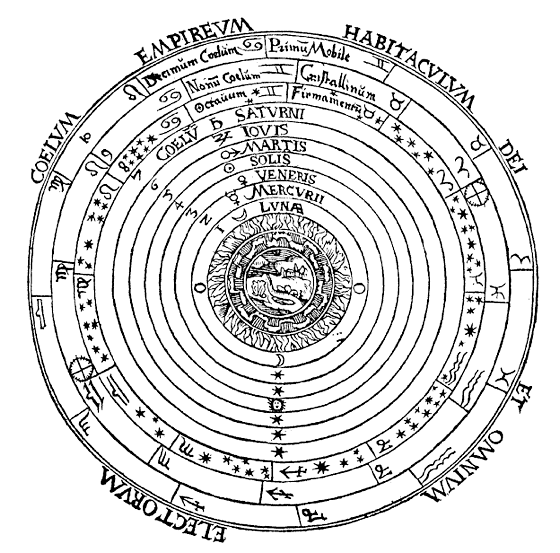
In this section, I use shifting ideas about what counts as a planet as examples of ontological remodeling. I interweave scientific history with brief explanations of the meta-rational themes it illustrates. This isn’t a general history of the changing understandings of “planets”; I’ve selected particular episodes for their relevance to the themes of The eggplant. However, I find these shifts fascinating, both as science and as history, so I go into a fair amount of detail. I think you’ll learn some surprising facts!
Wandering lights
It has long been established, by both evidence and rationality, that the gods live in the sky. As gods are important, the sky is of great interest to scientists. Besides gods, who are rarely observed, we see three categories of objects in the sky, distinguished by their modes of motion:
- Transient objects with irregular, unpredictable motions, such as birds, clouds, and comets. These can be seen to be quite close to the earth, which is also characterized by chaotic unpredictability and transience, so this makes excellent sense and is consistent with rationality.
- The stars, which are eternally unchanging, and whose motions are perfectly circular. There’s a simple explanation: they are fires visible through tiny holes in a black sphere, centered on the earth, that revolves daily. The sphere is clearly hundreds of miles away, close to the immortal gods, so this is also highly rational.
- Seven wanderers, or “planetai” in Greek. These are the Moon, the Sun, Venus, Mercury, Mars, Jupiter, and Saturn. Unlike stars, they speed up and slow down, slew sideways, and sometimes even go backward. Unlike birds and stuff, their motions are somewhat predictable, but in ridiculously complex patterns. This is not so obviously rational. What’s up with it?
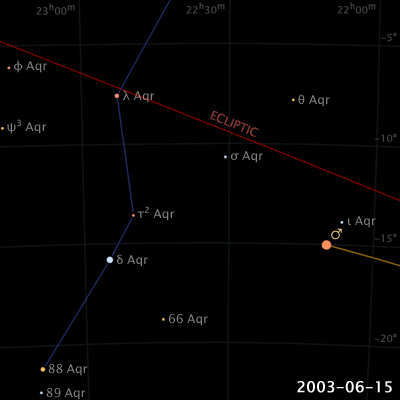
Apparently the Wanderers are an intermediate category, for which we need a rational explanation. Aristotle and his colleague Eudoxus figured out the basics, and Ptolemy nailed the details. The planets are attached to spheres, made of pure, eternal, aetheric crystal. Through cunning arrangement of several dozen of them, each moving in a perfect circle, the apparently complex planetary motions become perfectly predictable.
Or, to within a few degrees of angular error, anyway.
Unemployed angels, spirals, and the dark
What causes the aetheric spheres to rotate? Scientific opinion has varied. By the end of the Middle Ages, the general consensus was that each sphere was turned by an angel.
Then a revolution put the celestial company of angelic laborers out of work. Lacking alternative opportunities for employment, they ceased to exist.
That is, by Galileo’s time, strong evidence had accumulated that there were no spheres, and therefore no angels. We have no need of that hypothesis.
This is an example of categories (aetheric spheres, angels) completely vanishing during an ontological remodeling: outcome #1.
By contrast, the question “what makes heavenly bodies move in such complicated patterns” has come through multiple remodelings intact (outcome #3). We’re still making progress on it. For instance, recent work on the magnetohydrodynamics of galaxies seems to be converging toward an explanation for their previously-mysterious spiral shapes.
But we’re still far from a complete story. No one has a clue about the apparent acceleration of the universe’s expansion. It is attributed to “dark energy”; but that is a mere dormitive principle: a science-y name masquerading as an explanation. “Acceleration requires energy by definition, and we can’t find any, so it must be ‘dark energy’.” But “dark energy” is not compatible with any currently-credible physical theory.
Copernicus remodels the planets
You will recall, from invented history, that Copernicus set off the Scientific Revolution in 1543 by proving that Aristotle, Eudoxus, and Ptolemy were wrong, because the earth goes around the sun. This did not happen.2 He did propose a heliocentric (sun-centered) model that became influential starting several decades after his death, however.
Copernicus retained all the previous ontological categories, including circular orbits and crystal spheres; they came through the remodeling intact (outcome #3). Mostly, only their relationships changed.
The category most transformed was “planet.” This had two intertwined aspects: an ontological remodeling of the category, plus empirical claims about the nature of specific objects.
Ontologically, where “planet” had meant “lights that wander in the sky,” it now meant “things that go around the sun.” Empirically, the claim was that all the old planets go around the sun, except the moon and the sun itself, so those are not really planets after all. Most troublingly, the earth too goes around the sun, so it is a planet.
The earth does not wander in the sky; it does not glow like the planets; it is extremely large, whereas most planets are mere pinpoints. Why call the earth a planet? This made absolutely no sense in Copernicus’ time. The claim appeared not false, but absurd: a category error. But for Copernicus, the earth was a planet exactly in that it does wander around the universe, instead of sitting still at the center.
Maybe heliocentrism would have succeeded sooner if Copernicus used a different word for his remodeled category! This is a common pattern, though: an existing word is repurposed during remodeling. There is no fact-of-the-matter about whether “planet” denoted a new, different category, or if the category itself changed and kept its same name. As in the Ship of Theseus and Grandfather’s Axe parables, the continuity of identity of categories over time is nebulous.
Heliocentrism: absurd on the face of it
It took well over a century after Copernicus for most scientists to adopt heliocentrism. That was not mainly because of opposition from the Church, nor due to blind adherence to traditional authorities. It was because empiricism and rationality both contradicted his theory. In fact, multiple heliocentric models had been proposed by the Ancient Greeks—Copernicus got the idea from them—and they were periodically revived up to his time. They had always been dismissed as fanciful, for lack of evidence or sense. So was Copernicus’—for a long time.
The puzzle is not “why didn’t scientists immediately adopt heliocentrism once Copernicus proved it was true?” but “why did anyone take him seriously at all, considering he failed to give any adequate reason to think it was true?”
There was no good observational evidence for heliocentrism until Galileo observed the phases of Venus in 1610. Copernicus’ arguments all invoked conceptual aesthetics, not evidence.
Copernicus’s model explained dramatically fewer phenomena than the state of the art.3 It is difficult to convey how extensive and important geocentrism’s implications were. It was woven, with rational arguments, into the whole Aristotelian and Medieval Christian worldview. All those explanations now seem absurd, but they were vital at the time. When geocentrism failed, the entire prevailing structure of certainty failed with it, and nihilism became a serious threat. That was dispelled only when a new structure of explanation was constructed on the Newtonian model: namely, the modern world, or “systematic mode” of meaningness. (There’s an interesting parallel here with the nihilism precipitated in the 20th century collapse of the modern structure of understanding.)
Copernicus’s model gave no more accurate predictions of planetary motions than the best available geocentric models. And, contrary to the invented history you may recall, Copernicus’ model was no simpler than previous ones. In particular, it had more epicycles, which he needed in order to eliminate equants, another type of technical kludge that he particularly disliked.
There was also excellent evidence against heliocentrism. For example, the absence of stellar parallax was considered a fatal flaw until much later, when astronomers recognized that the “fixed” stars must be ridiculously far away.4
Heliocentrism: not known to be unfixable
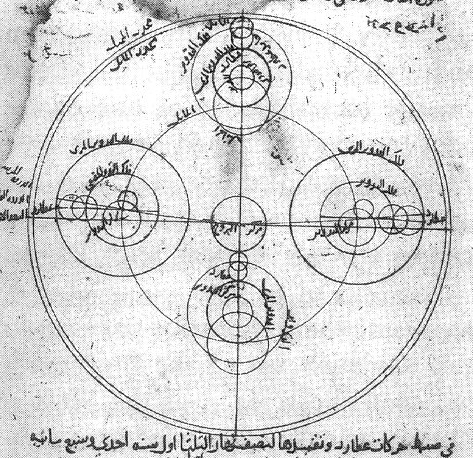
All geocentric systems—there were many—assumed an ontology of perfectly circular motions. To account for the apparently non-circular motions of the planets, they used complex combinations of epicycles, deferents, eccentrics, and equants. These were, effectively, mechanical linkages and offsets that produced complex motions as combinations of multiple circular ones.
The problem was to hook these devices up in a way to generate predictions that agreed with observations. Thousands of smart people worked on this for thousands of years, tinkering with the details, and made essentially no progress after Ptolemy (around 150 A.D.). The best models as of Copernicus’ time still predicted eclipses wrong by a day, and the position of Mars by a degree.
For astrologers, a day or a degree makes all the difference! This was highly unsatisfactory and discouraging. Most thought that eventually the discrepancies would be ironed out with a sufficiently clever arrangement of epicycles, but others recognized that something must be wrong.
For decades, the only people interested in Copernicus’ work were astro-math geeks who spent all their time trying to reorganize the gears to make the machine give the right answers. The fact that his system made absolutely no sense, considered as physics or cosmology, was not relevant for them. Astrologers were practical men, chronometric engineers whose livelihoods depended on accurate predictions, not highfalutin’ philosophy.5
Copernicus’ system was just another arrangement of circular motions via epicycles, deferents, and eccentrics. And it gave no better predictions than the state of the art. But it was sufficiently different that it wasn’t known to be unfixable. Every imaginable variant on geocentrism had been tried, and found not to work. Copernicus opened up new opportunities for obsessive tinkering that held out a reasonable hope of progress.
And, it turned out that other heliocentric arrangements could and did give somewhat more accurate results. Quite soon, everyone else relied on heliocentric calculations for prediction, even while firmly holding that they were a purely mathematical fiction—because, interpreted as physics, heliocentrism was a non-starter.
This is a pattern. When you are stuck, an alternative ontology may be attractive, even in the absence of other virtues, by giving you new ways of thinking about the problem.
Meta-rationality: not known to be unworkable
Just as problems with geocentrism had been known for centuries, problems with rationalism have been known for centuries. The logical positivists fixed some, but eventually gave up on trying to fix the rest. After centuries of failed attempts by super-smart people to create a workable version, it remains possible that somehow someone can make the overall approach succeed someday—but it no longer seems likely.
Heliocentrism had been around for centuries, and was only initially adopted by Copernicus and a few others in desperation, because it at least was something new to try.6
Analogously, meta-rationality has been around for more than half a century,7 and we can at least say that it’s not known to be unworkable. There has been continuing progress in making it handle more details; it seems plausible, to some smart people, that it can eventually encompass and supersede the rationalist worldview. However, it hasn’t been fully worked out, and it hasn’t been explained well,8 and for at least those reasons it is not widely accepted—or even known of.
Mistaken theories accumulate kludgy patches until there is a better alternative. Failure to account for data does not cause the demise of a theory. Rationalism persists, despite its well-known inadequacies, because it’s clearly better than irrationalism and anti-rationalism, the only well-known alternatives.
A meta-scientific revolution
Heliocentrism may be the most obvious example of ontological remodeling, because Thomas Kuhn’s 1962 The Structure of Scientific Revolutions highlighted it.
Historians agree that Kuhn’s book dealt the death-blow to logical positivism. That is not because he gave a knock-down argument against it; he didn’t attempt to. It is because, like geocentrism, it had become obvious that no one could make logical positivism work, despite decades of brilliant scientists and philosophers trying.9 Kuhn sketched an alternative that was radically different, plausible, and not known to be unworkable. And, it was easy to see how to fill in the details by doing more work of the sort he pioneered.
Kuhn had two big ideas. The first is that, if we want to know how science works, we need to look and see how people do it. That sounds obvious, and scientific. However, all previous attempts had been derived from a priori armchair theorizing about how, rationally, science ought to work. As soon as you compare those with reality, it’s obvious that they are totally false as accounts of how science does work. Somewhat less obviously, once you start to understand how science does work, you can see that rationalist ideas about how it ought to work are also wrong: it shouldn’t and couldn’t work that way.
By looking to see how science does work, Kuhn came to his second big idea. He found that science sometimes requires ontological remodeling, and that the type of reasoning scientists use for that is distinctively different from the type of reasoning they use when their ontology is adequate. During crisis periods, when an ontology breaks down, scientists evaluate, select, combine, modify, discover, and create alternatives. That is: “revolutionary science” requires meta-rational reasoning, whereas rationality is adequate for “normal science.”
Because he said that scientific progress depends on non-rational reasoning, Kuhn was widely misunderstood as advocating irrationalism—the only well-known alternative. Both his proponents and opponents jumped to the conclusion that, if he said scientific revolutions are not rational, he must mean they are intuitive, mystical, emotional, or political.10 That led to heaps of harmful New Age woo.
Kuhn’s confusing presentation11 also led to a horribly missed opportunity. Most scientists dismissed Kuhn’s observations. If he had explained them more clearly, scientists might have embraced them, and that might have led quickly to improved scientific practice.
Nevertheless, The Structure of Scientific Revolutions was an instance of the thing it describes. It was a dramatic ontological remodeling of the scientific understanding of a domain of phenomena: in this case, science itself.
It is no longer credible to make theories about how science does or should work without taking into account detailed empirical evidence. It is no longer credible to claim that science is a solely rational activity. And there has been no serious attempt to construct a new rationalist account of science since Kuhn’s publication.
Gerrymandering the solar system
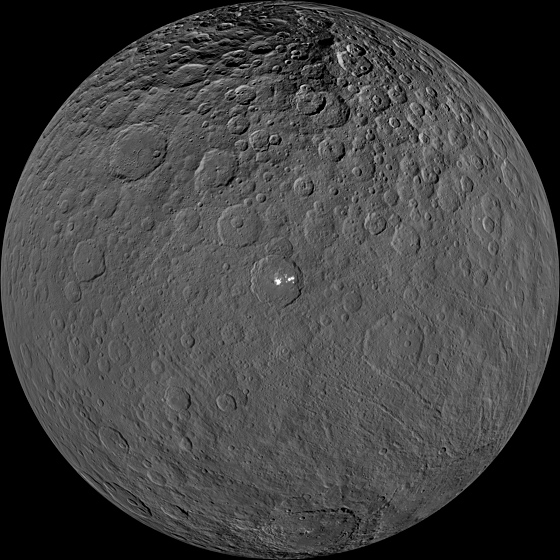
The planet Ceres was discovered in 1801. It was found just where theory had predicted there should be a planet, between Mars and Jupiter. Over the next few years, three more planets were found in the same region: Palas, Juno, and Vesta.

Vesta was the last new planet until the 1840s. Then, within a few years, there came a dozen more. Inventing new planetary symbols for them became a headache. In 1851, that was resolved by giving them numbers instead. Ceres became object #1. But if they weren’t going to get planetary symbols, maybe they weren’t planets, even though they were “things that go around the sun,” which had been the meaning of “planet” since the heliocentric revolution. Anyway, they were small and boring, and who knows, there might be hundreds of them.12 The whole lot got demoted to “asteroids.”
Ceres and the others ceased to be planets—but “planet” was not actually redefined. There was no specific criterion given for why they didn’t count. For the next century and a half, “planet” was implicitly defined just as a list: these eight things (and then nine, with Pluto) are the planets. They share some family resemblance, so that was an entirely reasonable solution—although not formally rational. There were no marginal cases, so there was no need for a rigorous classification scheme.
As Heidegger observed in the seminal meta-rational text Being and Time, we only resort to formal rationality when reasonableness becomes inadequate. Even for most routine science, reasonableness does the job much of the time. When that breaks down, in a crisis, you need to step back and get rational. If that too fails—as it did in 2006—you have to get meta-rational.
“Planet” started to break down in the 1990s, as numerous marginal cases were discovered: both outside and inside our solar system.
The first exoplanet—orbiting a star other than our sun—was discovered in 1992, and many more soon followed. But this made practical a problem that had previously only been theoretical. What sorts of things orbiting a star count as planets?
There’s only three kinds of things that go around our sun: rocks, clouds, and snowballs. There’s all kinds of weird things going around other stars: gigantic diamonds, spacetime singularities, neutronium slag-heaps, and who knows what all else. Which ones should count as planets, and why? That problem made everyone uneasy; but it still hasn’t come to a head, and remains unresolved.
Meanwhile, there had long been reasons to think there might be more planets beyond Pluto, but none had been found. Starting also in 1992, several pretty big things were discovered out there. Should they count as planets?
Well, who cares? “It’s just a word…”
The International Astronomical Union cares, that’s who. They have to care, because in 1851 it was decided that non-planets get sequential object numbers, and planets don’t. It’s the IAU’s job to assign the numbers, and either the new things had to get them, or not. (This was a weird echo of Ceres being reclassified partly because of trouble with assigning new planetary symbols.) The IAU reached no decision for a decade.
Finally, the issue was forced by the discovery of Eris, named—deliberately—after the Greek goddess of discord. Eris is more massive than Pluto. If the argument for denying planetary status to the new things was that they weren’t big enough, relative to some arbitrary cut-off value, then either Eris is a planet, or Pluto isn’t.
The question became intensely political. Not only did some astronomers have passionate opinions, so did the public. The public’s opinion was that they learned in school that Pluto was a planet, and who are these clueless ivory tower eggheads to say otherwise? It might be interesting to understand that irrationality better;13 but still more mysterious was the “rational,” “scientific” debate.
The problem was that there is no rational classification scheme that includes the nine traditional planets while excluding Eris and her Trans-Neptunian friends.
In fact, there is no rational classification scheme that includes the nine traditional planets, period. They have nothing in common. Jupiter, for instance, is a medium-sized cloud, whereas Earth is a small rock. (Jupiter is “medium-sized” inasmuch as equivalent objects outside the solar system can get thirteen times bigger before they reach the critical mass for deuterium fusion and become brown dwarfs—objects that can’t make up their minds about whether they are big planets or small stars. Earth is “small” inasmuch as Jupiter has 318 times its mass and 1,321 times its volume.)
You could say that planets are “big enough” things that go around the sun; but what should the size cut-off be? You can bite the bullet and exclude Eris by demoting Pluto—which, to be fair, is much smaller than the other eight traditional planets. But then you have to pick some arbitrary size threshold, which doesn’t seem very rational. If you are going to do that, a more rational cutoff might fall in the huge gap between the small rocky planets (Mercury, Venus, Earth, Mars) and the big cloudy/snowy ones (Jupiter, Saturn, Uranus, Neptune).
Fortunately, there is another fairly natural size cutoff. Big enough objects collapse into a sphere, crushed by their own gravity. In 2005, as the crisis reached the boiling point, the most reasonable proposal was to define “planet” as “a sphere that goes around the sun.” This isn’t particularly rational, since it’s not clear why we should care either about going around the sun or sphericalness, but at least it’s concise.
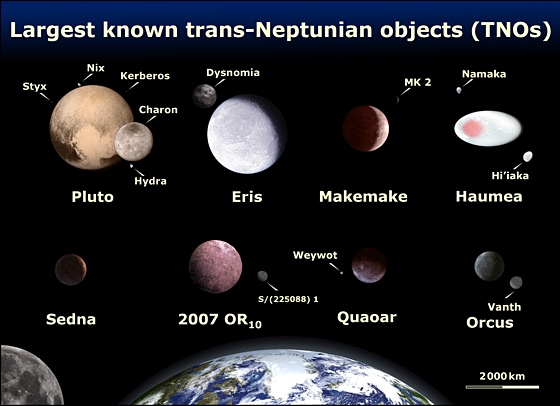
This proposal would have made Ceres a planet again—but not any of the other asteroids, because they aren’t quite big enough to collapse. It would also include Eris and half a dozen other spherical things beyond Pluto. I would have liked that, because they are cute. However, there may be hundreds of spheres out there, and in 2005—just as in 1851—many astronomers’ opinion was that having hundreds of planets is not OK.
So that proposal was rejected. Instead, in 2006, the IAU added a third criterion: to count as a planet, an object has to “clear the neighborhood around its orbit.” Eris and Pluto were declared to have failed to do so, and were made non-planets. Pluto, which we discovered had never really been a planet after all, got a belated number: 134340.
The IAU did not define what “clearing the neighborhood” means. No planet has fully cleared its orbit; there’s lots of minor junk in Earth’s neighborhood. Various complex mathematical definitions have since been suggested, all of which involve some arbitrary numerical cutoff for what counts as the neighborhood and how clear it has to be.
The 2006 definition put spherical things that go around the sun but don’t clear their neighborhoods—such as Ceres, Eris, and Pluto— in a newly invented category of “dwarf planets.” Those are officially ABSOLUTELY NOT PLANETS, despite the name.
The word “dwarf” betrays the agenda here. What proponents really wanted was a size cutoff between Eris and Mercury, the smallest of the remaining “real planets.” That would preserve the traditional list as nearly as possible. However, there’s no rational reason for drawing a line there, so they came up with sciencey-sounding “clearing” criterion instead.
Ignored during the debate was what seems to me a serious bug. Jupiter doesn’t go around the sun, and therefore is not a planet by the 2006 definition.
Don’t believe me? In Newtonian mechanics, two bodies orbit their barycenter, or center of mass. If they have equal masses, the barycenter is the midpoint between them. If one is heavier than the other, the barycenter is closer to it. If one has much greater mass than the other, their common barycenter is located within the larger body, and the smaller object goes around that point. Only then is the smaller body said to orbit the larger one. Otherwise, the two form a binary system.
Jupiter is ludicrously heavy: it has 2.5 times the mass of everything else in the solar system combined, apart from the sun. The sun is much heavier still—but the barycenter of their mutual orbit is outside it. Jupiter and the sun are a binary system. Their barycenter is, to be fair, quite close to the sun, and informally it may be reasonable to say Jupiter goes around it. But in terms of the formal definition, it doesn’t, so by the IAU criteria, Jupiter is not a planet.
Anyway, why is “goes around the sun” significant? If we’re interested in what’s there, we don’t care. “Goes around the sun” was meant to exclude large, spherical “moons,” seemingly just because they weren’t traditionally considered planets.
Jupiter is a useless blob, but its moons are the most likely places to find extraterrestrial life. Ganymede, the largest, is bigger than Mercury; and several are compositionally similar to the rocky planets. Considered on their own, it would make better sense to group them with Mercury, Venus, Earth, and Mars than with snowball moons that aren’t much bigger than a breadbox.
The resulting ontology can only be described as “gerrymandered.” Arbitrary boundaries were drawn to include and exclude particular objects, resulting in a contorted mess:
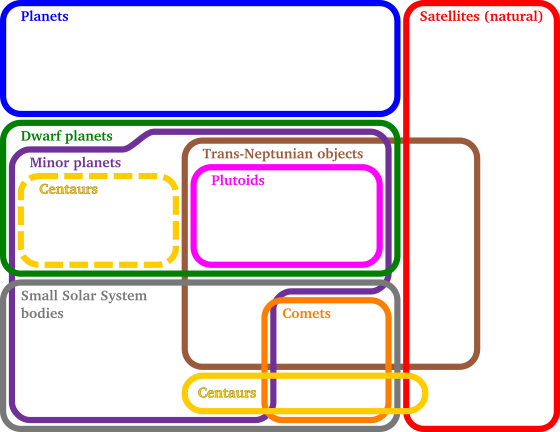
Meta-rational lessons from a scientific failure
The planetary definition controversy, and its outcome, were a farce—as is widely recognized.
It is a case study in ontological remodeling having failed due to people trying to use rational, rather than meta-rational, methods. “There must be a correct answer” is the characteristic error of rationalist eternalism.
The problem in classifying solar system objects is that there are different dimensions on which they vary. For example, you could group them by their history (how and where and when they formed), their current characteristics in isolation (size, composition, surface temperature), or their orbital dynamics (barycenter, eccentricity, “neighborhood clearing”). These axes would cluster objects quite differently.
There is no correct answer—or, the right answer depends on what question you are asking. If you are interested in dynamics, it doesn’t matter what an object is made of; if you are interested in astrobiology, it doesn’t matter where it came from.
Meta-rationality treats all categories as inherently purpose-laden—including scientific categories. It rejects the rationalist ideal of perfectly disinterested Truth. Any useful categorization of solar system objects would group them according to a sub-discipline’s interests. Dynamicists and astrobiologists would naturally come up with different ones.
Meta-rationality accepts, applies, and coordinates multiple ontologies for a single domain. There isn’t a great example in our solar system, but astrobiologists exploring other star systems might need to take dynamical considerations into account. Hopefully they would have no difficulty holding both classification schemes in their heads at once. Investigating the ruins of an ancient civilization on an unusual natural object in the Alpha Centauri system, they should not get sucked into arguments about whether it is “really” a planet.
By trying to force a single, purpose-free ontology onto the solar system, the IAU process came up with a classification that is entirely useless. The legacy planet/non-planet distinction, which the 2006 redefinition did its best to preserve, does not line up with any property we now care about. Implicitly, it amounts to “observable with the telescope technology of the 1700s.” This is a pattern: people get attached to categories for irrational reasons, and find spurious, “rational” justifications for them long after they have ceased to function.
Meta-rationality treats all category boundaries as inherently nebulous and malleable. It recognizes that there are always marginal cases. Those have to be dealt with pragmatically—taking into account context and purpose—because there is no rational standard.
The IAU process took for granted that there had to be a sharp, definite distinction between planets and non-planets. (Saying “this is dumb, it doesn’t matter” was not considered an option. Either Eris was going to get a number, or not.) To its credit, the IAU recognized that an arbitrary size cutoff was irrational. However, faced with marginal cases, there was no other “rational” solution. The arbitrary cutoff was hidden behind the figleaf of the “clearing” criterion.
The problem the IAU faced was not one of linguistic ambiguity. It was not a problem with words and definitions. “It’s just a word!” was not a solution. It was a problem of ontology: how do we divide up the world? Once a boundary is chosen and agreed on, sorting out words is usually easy. (Especially for scientists, who understand better than most people that we can give technical terms any meanings we want.) Sometimes people get attached to particular words, and sometimes arguments are genuinely linguistic. However, in most arguments supposedly about word meanings, the underlying issue is ontological: where do we draw a boundary?
The IAU was aiming for remodeling outcome #3: an improved, formal definition of an existing category. What they got was outcome #2: the category has disintegrated, and de facto has no formal status. It’s widely understood that the 2006 definition is pointless and silly. The process crystalized the recognition that there is no longer any meaningful, definite category called “planet,” and there never will be one again. On the other hand, it remains perfectly reasonable to talk about “planets” in other star systems—so long as you recognize that this is an informal usage. Outcome #2 melted the category, but it is not that “there is no such thing as a planet” or “planets don’t exist.”
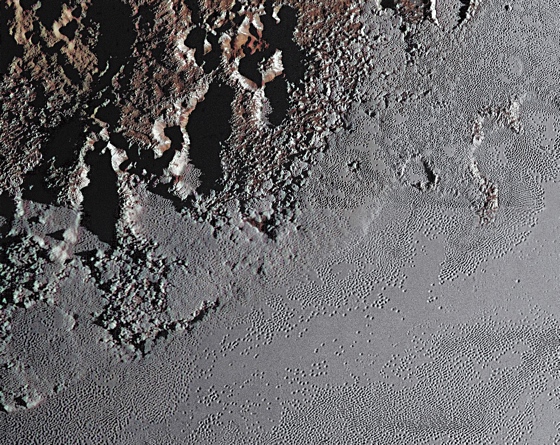
Planetary science is now making extraordinary progress, without any meaningful definition. In 2006, almost nothing was known about Pluto besides its mass, diameter, and orbit. Last year, a space robot sent back 6.25 gigabytes of information about it—and the discoveries are stunning. We now know far more about planets than when they were a (misleading) category. That knowledge depends on, and also implies, understanding the details of their heterogeneity.
We understand what each specific planet is vastly better than ever before. But we don’t have any general theory of planets, because they don’t have anything meaningfully in common (that other things don’t).
In the case of the planetary definition debacle, the various meta-rational lessons I’ve drawn here should be obvious—which shows that meta-rationality is not restricted to esoteric masters, but available to anyone with basic rationality skills.
Taking the same analysis to the meta level…
After the meta-rational remodeling of the rationalist categories “truth,” “belief,” and “reasoning,” we can understand specific instances much better than in the rationalist view. It is not that “there is no such thing as a truth” or “truth doesn’t exist.” But we can’t have any general theory of truths, because they don’t have anything meaningfully in common. Different, informal notions of truth apply in different situations. Meta-rationality looks at details to understand how “truth” operates in specific contexts, for specific purposes.
- 1.See “A first lesson in metarationality” for an introduction to ontological remodeling. I’ll return to the topic only briefly near the end of The eggplant. Detailed discussion of methods of remodeling will have to wait for future texts.
- 2.My main source for the history of heliocentrism is Thomas Kuhn’s The Copernican Revolution, which I recommend highly. It is simultaneously super geeky and admirably easy to read. He wrote it sixty years ago, and probably there’s been significant historical research in the mean time. However, from casual investigation only, it appears that none of his main conclusions have been overturned.
- 3.Copernican heliocentrism did explain some phenomena previous systems couldn’t. Particularly, it unambiguously determined the diameters of the planetary orbits. We’ll see that this is typical of ontological remodelings: the new and old models explain different subsets of phenomena, or explain them more and less well.
- 4.Copernicus did give this explanation, to his credit. Stellar parallax was finally observed, after sufficiently accurate instruments were developed, in the 1800s.
- 5.Besides astrologers, the other early enthusiasts for Copernicanism were Neoplatonic mystics. They thought, for spiritual reasons, that the universe ought to conform to simple mathematical rules; in their view Ptolemaic geocentrism was a godawful mess of kludges. The outstanding example was Kepler, whose heliocentrism was based on a Neoplatonic emanationist conviction that the Sun was God’s manifestation in the material realm, and therefore ought to be at the center of the universe. Fortuitously, his certainty that simple mathematical relationships must determine the cosmos led to his weird-but-true theory of elliptical orbits, which both dramatically simplified Copernicus’ system and gave much more accurate predictions. It also led to his elegant-but false theory that the distances between the planets related to the regular polyhedra. It’s interesting—but probably not significant—that the earliest advocates for what was later considered the first step in the Scientific Revolution were all woomeisters, who were right for the wrong reasons.
- 6.In Copernicus’ own words: “I pondered long upon this uncertainty of mathematical tradition in establishing the motions of the system of the spheres. At last I began to chafe that philosophers could by no means agree on any one certain theory of the mechanism of the Universe, wrought for us by a supremely good and orderly Creator, though in other respects they investigated with meticulous care the minutest points relating to its circles. I therefore took pains to read again the works of all the philosophers on whom I could lay hand to seek out whether any of them had ever supposed that the motions of the spheres were other than those demanded by the mathematical schools. I found first in Cicero that Hicetas had realized that the Earth moved [and so did various other ancients; Copernicus quotes them here]. Taking advantage of this I too began to think of the mobility of the Earth; and though the opinion seemed absurd, yet knowing now that others before me had been granted freedom to imagine such circles as they chose to explain the phenomena of the stars, I considered that I also might easily be allowed to try whether, by assuming some motion of the Earth, sounder explanations than theirs for the revolution of the celestial spheres might so be discovered.”
- 7.One might take as founding texts Heidegger’s Being and Time, published in German in 1927 and in English in 1962; Wittgenstein’s 1953 Philosophical Investigations; Kuhn’s 1962 The Structure of Scientific Revolutions; and Garfinkel’s 1967 Studies in Ethnomethodology. Key later works include Kegan’s 1982 The Evolving Self and Schön’s 1983 The Reflective Practitioner.
- 8.Each of the books I listed as a key meta-rational text is famously difficult to read. I would suggest going to secondary sources before tackling the originals.
- 9.Kuhn was in the right place at the right time. If he had published the same book thirty years earlier, it might have had much less impact, because logical positivism still seemed to be making progress.
- 10.Intuition, mysticism, emotions, and politics do all play some role in most scientific revolutions—as they do in all human activity. They are not the way scientific revolutions produce better ontologies, though.
- 11.One major problem was that Kuhn used the word “paradigm” for several quite different concepts. Consequently, “paradigm shift” has come to mean anything, and therefore nothing. (“Ontological remodeling” is one of the phenomena Kuhn was pointing at, but he didn’t use that phrase.) Another problem was that he didn’t apply any unifying label to the various sorts of reasoning I’m calling “meta-rational.” He just pointed out specific examples and some patterns. If he had labeled the category, it would have been easier to understand what he was contrasting with rationality. It would have been harder to imagine it was mysticism. His 1969 Postscript to the second edition tried to fix these problems, but it was already too late. If you read the book, don’t skip the Postscript! In fact, it might be the best place to start.
- 12.A plausible hypothesis, but wrong. There are millions of asteroids, not hundreds. Probably billions, depending on where you arbitrarily cut off their lower size limit.
- 13.Neil deGrasse Tyson wrote a book about this, The Pluto Files, with many quotations from the public debate. It’s a lot of fun, but doesn’t give much insight into why anyone cared.